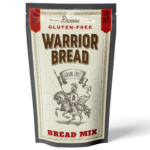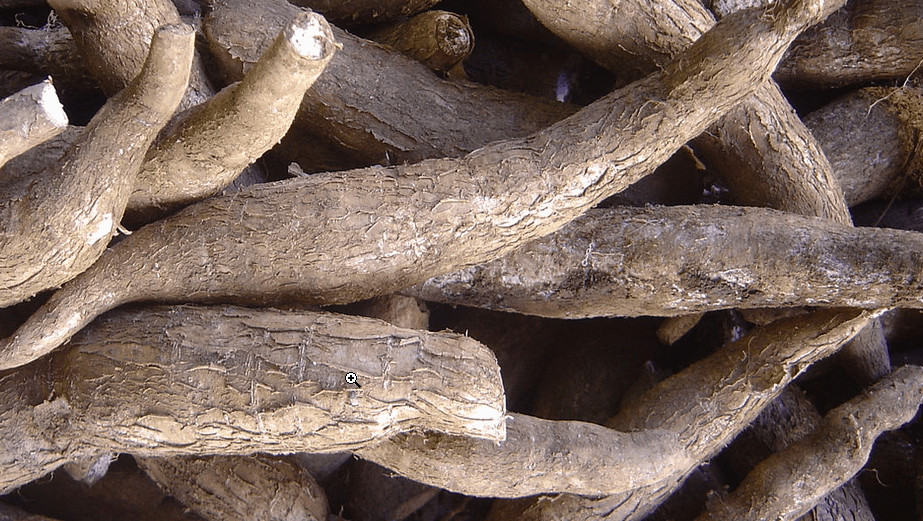Gluten-Free Flour Substitutes – Here’s the Breakdown
Have you been looking for gluten-free flour substitutes? We’ve got your back. The moment when a person realizes they are gluten sensitive or have celiac disease, they think to themselves, I can never have bread or desserts again! This couldn’t be further from the truth because yes, you can still have them! There are great gluten-free flour substitute options that are available at grocery stores. Here is a partial list of gluten-free flour substitutes: almond, cassava, arrowroot, coconut, tiger nut, tapioca, green banana flour, and gluten-free all-purpose flour. Just learning how to incorporate them into your recipes is the key to replicating your favorite bread and desserts without the inflammatory effects of gluten and grain!
In choosing your gluten-free flour substitute, make sure you do not have any allergies to a specific ingredient in the flour. If you try one gluten-free flour substitute and end up with a stomach ache or diarrhea, then you know it’s not the right flour for you to use. You don’t have to be an expert baker to recreate your favorite recipes, but it does take a little trial and error when working with a gluten-free flour substitute.
Almond Flour is Grain-Free
 Almond flour is a great gluten-free flour substitute.
Almond flour is a great gluten-free flour substitute. If you are not allergic to almonds, and you like the nutty flavor, it can be a great
gluten-free flour substitute for regular all-purpose flour. It is high in protein and low in carbohydrates and is a good source of fiber and vitamin E. For cakes, cookies, and muffins, a 1:1 substitution for all-purpose flour is appropriate for most recipes
5. Adding slightly more of your leavening agent is a good tip as well. Almond flour is a heavier flour, so leaving your baked product in the pan a little longer after removing it from the oven is best. You can find almond flour at most grocery stores or you can try and make it yourself at home. The brand you use absolutely matters. I highly recommend our very own,
Warrior Bread Mix.
Coconut Flour is An Excellent Gluten Free Flour Substitute
Next up is coconut flour. This flour can be used as a gluten-free flour substitute in many recipes, but you have to like the coco-nutty flavor as it will impart in your final product. Coconut flour is made from the meat of fresh coconuts. It is a great source of fiber and is low in carbohydrates, which makes it very friendly for diabetics. Due to its high fiber content, coconut flour will soak up moisture in your recipes. For baked goods, it is best to add an extra egg, chia seed or flax seed slurry, unsweetened applesauce or water to keep your recipe moist. Coconut flour can also be used as a thickener for gravies, soups, stews, and roux. Most grocery stores will carry this gluten-free flour substitute or it can be
purchased online.
Cassava Root Flour

New on the market for paleo diet followers is cassava flour. This is made from the entire tuber root, yucca
and is a great gluten-free alternative to flour. It maintains its earthy and nutty flavor and is much lighter than all-purpose flour. Because of this lightness, it will soak up moisture easily in your recipes (similar to coconut flour). For those with gut sensitivity, this flour is very easily digested. Although it is higher in carbohydrates than
any other gluten-free flour substitute, it is lower in sodium, fat, sugar, and overall calories than almond or coconut flour. It also has a good source of vitamin C. Cassava flour can be used to bake brownies, cookies, pita bread, tortillas, pizza crust, and many other baked goods. Using cassava flour can give recipes a boost in fiber as well. It can also be used as a thickener to make gravies and roux, or used as a binder for hamburgers and meatloaf. However, a little trial and error will be needed to master your recipes. Cassava flour is found in the grain-free bakery section of natural food stores, or it can be
found online.
For a Bread Like Texture – Tapioca Flour Works Great
Similar to cassava flour is tapioca flour. The terms are not interchangeable due to the differences in their sources. Tapioca flour, which has a neutral taste, is extracted from the wet pulp of the yucca root. The starchy liquid is bleached and dried into flour. Tapioca flour is high in carbohydrates and has a high glycemic index, so it should be used in moderation, especially in people with diabetes and blood sugar problems. Occasional uses can be replacements for cornstarch to thicken gravies and soups but may require adding ½ TBSP more to your recipe
1. A popular Brazilian bread, Pao de Queijo, is made with tapioca flour and it produces a nice light fluffy texture. Other recipes include tapioca tortillas, chips, and cakes. Tapioca flour can be purchased in the gluten and grain-free aisle at most grocery
stores or online.
Arrowroot is a Gluten Free Flour Substitute
Arrowroot flour is another great gluten-free flour substitute. It is extracted from the pulp of the arrowroot plant,
Maranta arundinacea. Arrowroot flour is high in protein and it is loaded with nutrients. It is easily digested and can be used in recipes for those who have a sensitive gut. Arrowroot is known to also help regulate blood sugar and cholesterol levels. Like tapioca flour, arrowroot has a neutral taste. It can also be substituted for cornstarch as a thickening agent in soups, gravies, sauces, stew, puddings and custards. Arrowroot starch can be used in baked goods, substituting ¼ of the recipes’ flour
6. It can also be used to add a crispy texture to “oven-fried” foods. Experimentation is the key to working with arrowroot flour. It can be found in most grocery stores.
Tiger Nut Flour (No, it does not come from actual tigers)
Trending upward as a gluten-free flour substitute is Tiger Nut flour. It is not made from a nut but from a root plant. Tiger nut is high in fiber and protein and helps maintain blood glucose levels. It is a resistant starch that can keep the gut healthy by feeding good bacteria. Taste-wise, it is nutty and sweet. It can be used to bake cookies, brownies, pancakes, tarts, doughs, and even in hamburgers. Baking requires a 1:1 substitution ratio for wheat flours
2. Again, trial and error are needed to perfect your favorite recipes. Tiger Nut flour can be found at natural food stores and is
available online. You can also find Tiger Nuts, which can be a great grain-free snack.
Green Banana Flour
Super brand new to the gluten-free flour substitute list is green banana flour. It is made from unripe green bananas and processed before the natural fruit sugars are formed. Green banana flour is loaded with nutrients, specifically potassium, and is a highly resistant starch. This makes it a healthy choice for the gut. It has an earthy flavor and can be used in smoothies, muffins, cupcakes, cookies, breads, cakes, waffles, and as a thickener for sauces. For baking, use 1/3 cup less green banana flour than wheat flour to substitute in your recipes
7. Experimentation is the key to having success in your recipes. Green banana flour can be
purchased online.
Chestnut Flour
Chestnut flour, which is derived from a tree nut, is one of the most underused as a gluten-free flour substitute. Well, at least in the United States. Nutrient-wise, it is very low in fat but contains a high starchy content similar to grain flour. It is still considered a high glycemic index food, GI = 65
8. However, this is much lower compared to whole wheat flours, GI = 85.
For your gluten and grain-free recipes, you can substitute 1:1 for whole wheat flours if you do not have an allergy to chestnuts. Chestnut flour is similar to Tiger Nut flour’s earthy and nutty flavor. It is best used in crepes, breads, madeleines, muffins, pastas, and cakes (except angel food cakes). Chestnut flour can also impart a sweetness to your recipes, so it is suggested to mix almond flour or coconut flour along with it. The texture of chestnut flour is similar to whole wheat flour and does not require additional eggs or moisture like coconut flour. Your best bet is to purchase
chestnut flour online and to experiment with it in your gluten and grain-free recipes.
All of these gluten-free flour substitutes can be used to recreate your favorite recipes, but they should be used in moderation in your diet. Make sure you always read the ingredients. Many companies add filler agents,
gums, sugars, processed preservatives, etc to their flour mixes. Choose only quality organic gluten-free flour substitutes made from natural sources, and set aside time to experiment with their many uses.
Don’t be shy and help a gluten-free warrior out. List other flours and recipes you have had success with below, and make sure to check out the recipe section in our
forum here <<<
If you are wondering if you have a gluten intolerance, take our sensitivity test today!
Always looking out for you,
Dr. Osborne
References
- Food is Medicine. (2016). Cassava Flour: The Best Grain-Free Baking Alternative? Retrieved from Cassava Flour
- Harris, Jennifer. (2015). What is Tigernut Flour? Gluten Free Living. Retrieved from Tigernut Flour
- Mercola. (2016). What is Arrowroot Good For? Retrieved from Arrowroot Uses
- Mercola (2015). How to Cook with Coconut Flour. Retrieved from Cooking with Coconut Flour
- She Knows Food & Recipe Editors. (2016). How to cook with almond flour, your new gluten-free baking buddy. Retrieved from Almond Flour
- Stuart, Stephanie. (2014). Paleo Diet Food List. Original Eating. Retrieved from Arrowroot
- Why Banana Flour. (2016). Retrieved from: Banana Flour
- Discovering Chestnut Flour (2009). Retrieved from: Chestnut Flour

 Almond flour is a great gluten-free flour substitute. If you are not allergic to almonds, and you like the nutty flavor, it can be a great gluten-free flour substitute for regular all-purpose flour. It is high in protein and low in carbohydrates and is a good source of fiber and vitamin E. For cakes, cookies, and muffins, a 1:1 substitution for all-purpose flour is appropriate for most recipes5. Adding slightly more of your leavening agent is a good tip as well. Almond flour is a heavier flour, so leaving your baked product in the pan a little longer after removing it from the oven is best. You can find almond flour at most grocery stores or you can try and make it yourself at home. The brand you use absolutely matters. I highly recommend our very own, Warrior Bread Mix.
Almond flour is a great gluten-free flour substitute. If you are not allergic to almonds, and you like the nutty flavor, it can be a great gluten-free flour substitute for regular all-purpose flour. It is high in protein and low in carbohydrates and is a good source of fiber and vitamin E. For cakes, cookies, and muffins, a 1:1 substitution for all-purpose flour is appropriate for most recipes5. Adding slightly more of your leavening agent is a good tip as well. Almond flour is a heavier flour, so leaving your baked product in the pan a little longer after removing it from the oven is best. You can find almond flour at most grocery stores or you can try and make it yourself at home. The brand you use absolutely matters. I highly recommend our very own, Warrior Bread Mix.
 New on the market for paleo diet followers is cassava flour. This is made from the entire tuber root, yucca and is a great gluten-free alternative to flour. It maintains its earthy and nutty flavor and is much lighter than all-purpose flour. Because of this lightness, it will soak up moisture easily in your recipes (similar to coconut flour). For those with gut sensitivity, this flour is very easily digested. Although it is higher in carbohydrates than any other gluten-free flour substitute, it is lower in sodium, fat, sugar, and overall calories than almond or coconut flour. It also has a good source of vitamin C. Cassava flour can be used to bake brownies, cookies, pita bread, tortillas, pizza crust, and many other baked goods. Using cassava flour can give recipes a boost in fiber as well. It can also be used as a thickener to make gravies and roux, or used as a binder for hamburgers and meatloaf. However, a little trial and error will be needed to master your recipes. Cassava flour is found in the grain-free bakery section of natural food stores, or it can be found online.
New on the market for paleo diet followers is cassava flour. This is made from the entire tuber root, yucca and is a great gluten-free alternative to flour. It maintains its earthy and nutty flavor and is much lighter than all-purpose flour. Because of this lightness, it will soak up moisture easily in your recipes (similar to coconut flour). For those with gut sensitivity, this flour is very easily digested. Although it is higher in carbohydrates than any other gluten-free flour substitute, it is lower in sodium, fat, sugar, and overall calories than almond or coconut flour. It also has a good source of vitamin C. Cassava flour can be used to bake brownies, cookies, pita bread, tortillas, pizza crust, and many other baked goods. Using cassava flour can give recipes a boost in fiber as well. It can also be used as a thickener to make gravies and roux, or used as a binder for hamburgers and meatloaf. However, a little trial and error will be needed to master your recipes. Cassava flour is found in the grain-free bakery section of natural food stores, or it can be found online.

37 Responses
I here that quinoa is an excellent choice for protein, but is it gluten-free?
Rosemarie,
Quinoa is not recommended. It has proteins that mimic gluten. Read this article to learn more about this https://env-gfsociety-staging.kinsta.cloud/is-quinoa-a-safe-gluten-free-food-alternative/
All the best,
Dr. Osborne
I use buckwheat and coconut flour.
I see numbered superscripts that look like footnote references but I don’t see the accompanying footnotes. What happened to them?
The references are at the end of the article, just before the comments begin.
Could you give me your opinion on chestnut flour which is readily available in Europe and UK and makes marvellous pancakes
Chestnut flour is OK for a gluten free diet 🙂
Best,
Dr. O
I have never seen Chestnut Flour before. Where can I find it?
Love them grew up having roasted chestnuts
During the Holidays
What about Amaranth flour?
Rozanne,
Amaranth and the other pseudograin flours (quinoa, buckwheat) are not recommended. The proteins in these can mimic gluten, and many have health issues when exposed.
In the first paragraph of this article you say buckwheat flour is ok. In this answer you say “pseudograin” flours like amaranth, quinoa and buckwheat are not recommended. Just to clarify, which is it?
Thank you.
So sorry Linda. Buckwheat is not recommended. The error above has been changed. You might find this article on buckwheat helpful as well. https://www.glutenfreesociety.org/is-buckwheat-gluten-free/
All the best,
Dr. O
Which flour do you recommend for someone who is trying to loose weight. Is honey a good substitute for sugar? Thank you.
Tecla,
Nut flours might be the best choice for you. I would also recommend you watch this video – https://www.youtube.com/watch?v=d_u6UMAT-Rg
All the best,
Dr. O
Hi, I am underweight with very mild prediabetes, what would you recommend?
Shirley,
Find a good FM doctor to work with. You might also consider reading and following the diet protocol in my book, No Grain No Pain.
All the best,
Dr. O
I have gluten sensitivity but find that I’m OK with making ‘Roman Bread’ using spelt flour, yeast, honey and warm water, 1 Tbs oil and some salt. Splet is ancestral flour, how much gluten does it contain compared to modern wheat, please?
Marcia,
If you are gluten sensitive, you should not be eating spelt. Remember that gluten is a trigger for autoimmune disease and can cause damage at 20 ppm.
All the best,
Dr. O
I have concerns about the inflammatory effects of mishandled unsaturated oils. Considering that nuts are so rich in them it seems counterintuitive to first increase oxidation potential by grinding the nut and exponentially increasing the surface area exposure to the air, and then adding insult to injury by heating those oxidized oils to baking temperatures? I’m surprised we’re still recommending them in anti inflammatory food prep. Are my concerns unfounded, Dr. O? P.S. Looking forward to shaking your hand in person one day.
Hi Juliana,
Your concerns are not unfounded 🙂 Any of these flours, in my humble opinion, should be used sparingly for various reasons, including the ones you so astutely brought up.
Looking forward to shaking your hand too!
All the best,
Dr. O
Is buckwheat not a herb?
Is Dr Osborne a doctor of nutrition or similar field?
My naturopath recommended I use a mixture of buckwheat and coconut flours to replace wheat flour, because of thyroid issues. So it’s confusing to read here that buckwheat is not recommended because it could mimic gluten flours. Is there proof to substantiate this previous statement? Also the recommendation to mix e.g. almond flour with all purpose flour – isn’t that a normal wheat flour? I also got the impression that coconut flour needs to be mixed with some other gluten free flour – 80:20 (20 being the ratio for coconut flour). But from this article I get the impression that it can be used entirely on its own. (?).
My understanding is that he is a nutrition expert with much education. I believe that most feel gluten is glidian (sp?) only so they do not consider rice or buckwheat or quinoa as gluten. Dr Osborn says and other nutritionists agree that if you are sensitive to one gluten protein others can cause sensitivity as well. So I avoid all grain even rice and oats. It has helped me greatly. Check out the Gluten Master Clsss by Dr Osborn. I learned so much in that free class. Then you can make an informed decision for yourself.
Hi Dr Osbourne, I’ve been true gluten free for nesrly thirty days I am really feeling great one thing though I miss my chocolate is chocolate ok once in a while?
What about acrylamide formation from roasting almonds, which should also pose a problem with almond flour?
Thank you Dr. Osborn,
I would love to print your article and share! Could you supply an icon?
I have several diagnoses, polymyalgia rheumatica, anti phospholipid syndromesnd polycythemua Vera all I’ve read about diet leaves me nothing to eat. No animal products for heart issues, no excessive greens on warfarin, no grains, no nightshades, no sugar, what do I eat? Please somebody help
Elizabeth,
You need to get with a highly qualified functional medicine doctor for guidance. Your diet is most likely overly restricted. Keep your chin up. There is hope!
All the best,
Dr. O
I guarantee if you can go with a Gluten Free diet & I also do a Pure Organic diet (if you can find it or believe the liar’s out there). Why Organic too, well No life forms can consume neurotoxic & carcinogenic petroleum by products that’ll just exacerbate all of the negative effects of gluten.
Dr. O saved me, when I knew I was dying, server RA & then the VA found Lymphoma & Bone Cancer in my bloodwork. Long story short, 6 months later on a clean as I could make it, GF & Organic only diet. No more RA, No Lymphoma or Bone Cancer, 9 months later, still clear.
This was in 2013 & I’m still clear Oct. 2023 blood work& doing Regenerative Organic Farming. Because Trust is Earned, Not Given.
Thank You Dr. O, for giving me my life back to me.
P.S. we don’t get sick anymore or any type of infections, another bonus & we no longer need to take any toxic medications either, which most all are based from petroleum.
How do you recommend finding a highly qualified Functional Medicine Doc? I’ve been searching, but not having great luck in my area. Thanks!
Hi, what is your opinion on chickpea flour ?
Yes l am looking for a grain free gutten free tree nut free flours that are low starch and that are good for persons with gut problems and that in the intestines will turn to killing bad bacteria l am under weight due to multiple food sensitivities l have leaky gut and irregular bowel and possibly epi it’s where the pancreas can’t dissolve starches properly and causes gut problems l stay frustrated to due my health worried about being under weight and never satisfied when l eat and always hungry due to the fact all l eat is protein and veggies and l also have candida and thrush can you help me
What about Teff flour?
My favorite flour substitute is sunflour made from sunflower seeds.
It has no gluten, obviously, but is it acceptable otherwise?
I react to almost all of the substitutions listed above, except for tapioca and arrowroot.
So I just wanna make sure… Buckwheat is approved? I actually digest it with no issues 🙂
Great article Dr.O. Tks. I see a lady asking about Chickpea flour. An Indian name for this is Besan flour, which we’ve been using for 5+ years w/o any digestive harm.
Makes a great porridge; off-white sauce; pancakes w/o eggs at a stretch, & bakes nice bread or choc cake with finely grated zucchini in the mixture. Finding it stone-ground is AAA but roller-milled is also OK. If i recall, it’s chickpeas that are used for isolating “pea-protein”, but we avoid that.
Mung-Bean flour should be OK too.
Wild rice flour is also excellent. As pricey as all the others but very nice to work with. I mix it half-and-half with coconut flour and sometimes do thirds with almond, wild rice and coconut.